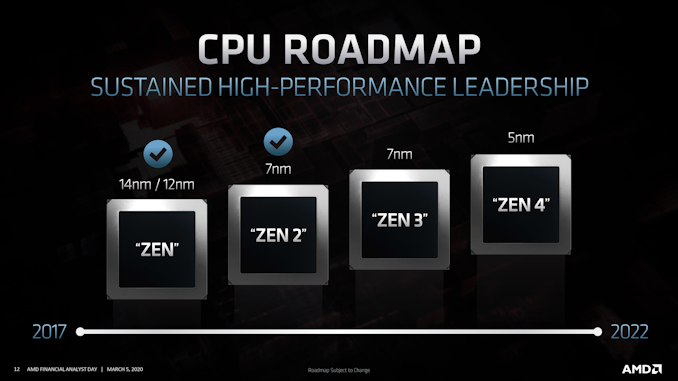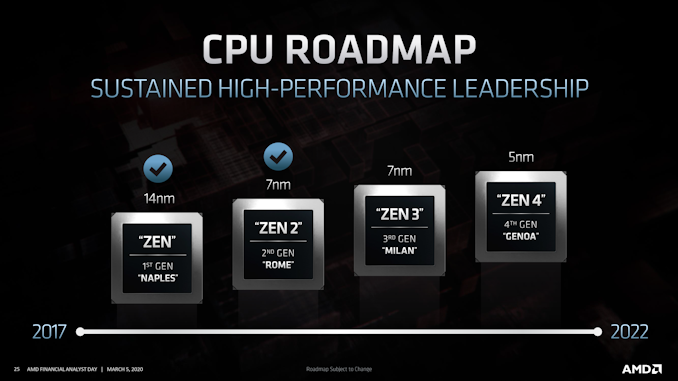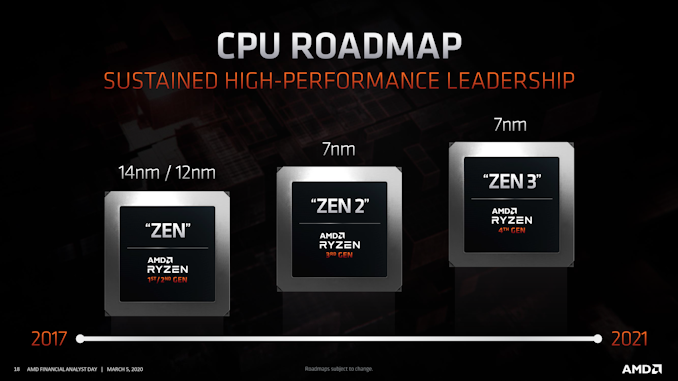Updated AMD Ryzen and EPYC CPU Roadmaps March 2020: Milan, Genoa, and Vermeer
by Dr. Ian Cutress on March 5, 2020 6:40 PM EST
Everyone is interested in roadmaps – they give us a sense of an idea of what is coming in the future, and for the investors, it gives a level of expectation as to where the company might be in a year to five years. Today at AMD’s Financial Analyst Day, the company gave the latest updates on the CPU side of the business, for consumer and for enterprise.
AMD stated that its CPU roadmaps for its enterprise portfolio are going to offer more vision into the future than its consumer side for a couple of reasons. First, the enterprise market is built on a longer product cycle and it helps when planning these systems to know what is in the pipe publicly, but also from an investor standpoint where the enterprise market ultimately offers the bigger financial opportunity.
To that end, AMD confirmed what we essentially knew, with Zen 3 based Milan coming in ‘late 2020’.
Zen 4 based Genoa has already been announced as the CPU to power the El Capitan supercomputer, and in this roadmap AMD has put it as coming out by 2022. We asked AMD for clarification, and they stated that in this sort of graph, we should interpret it as the full stack of Genoa should be formally launched by the end of 2022. Given AMD’s recent 12-15 month cadence with the generations of EPYC, and the expected launch of Milan late this year, we would expect to see Genoa in early 2022.
Astute users might notice that Milan / Zen 3 has been listed as ‘7nm’, where previously it was listed as ‘7nm+’. We’ve got a whole news post on why AMD has made this change, but the short of it is that AMD initially put ‘7nm+’ to mean ‘an advanced version of 7nm’. When TSMC named its EUV version of 7nm as N7+, people had assumed they were the same, and AMD wanted to clarify that Milan is on a version of 7nm, and the exact version will be disclosed at a later date. In the future the company will avoid using ‘+’ so this doesn’t happen again (!). We also have Genoa listed as a 5nm product.
Harder numbers about Milan and Genoa are expected to be unveiled closer to their respective launch times.
On the consumer side, AMD said a little less, with its roadmap only going out to Zen 3, which has the codename ‘Vermeer’ for the desktop product.
In this graph, we see that the Zen 3 product here is on the far right, but so is the date – 2021. Does this mean Zen 3 for consumers is coming 2021? We asked AMD to clarify, and were told that we should interpret this as that the range of Zen 3 consumer products, such as desktop CPUs, HEDT CPUs, mobile APUs, and consumer APUs, should all be available by the end of 2021. The company clarified that Zen 3 will hit the consumer market ‘later this year’, meaning late 2020.
So here comes a poignant question – what is going to come first in 2020? Zen 3 for enterprise is listed as ‘late 2020’, and Zen 3 for consumer is ‘later this year’. AMD makes a lot more money on its enterprise products than its consumer products, and while it enjoys a healthy performance lead in both, it really wants to push its market share in enterprise a lot more to drive home the bigger financial potential. With this in mind, I highly suspect that given AMD’s lead in the consumer market, we might see the company push more of its Zen 3 silicon into the enterprise market as a priority, with only a limited 2020 consumer release. I could be wrong, but we will find out closer to the time.
Interested in more of our AMD Financial Analyst Day 2020 Coverage? Click here.












60 Comments
View All Comments
Soulkeeper - Thursday, March 5, 2020 - link
Any mention of DDR5 support and timeframes on the AM4 replacement ?Will Zen3 launch with a new chipset and ddr5 ?
Luckbox - Thursday, March 5, 2020 - link
DDR5 would be too radical change for Zen 3.peevee - Friday, March 6, 2020 - link
Why? If it is basically the same 7nm, and likely still PCIe4 (which is fine), DDR5 is something which can offer some performance support, especially for APUs.Hul8 - Sunday, March 8, 2020 - link
It's an undisclosed "improved" 7nm process - not the same one.Super-expensive new memory type makes little sense outside enterprise, and even less for budget systems, such as those that would even consider APUs.
For Zen, the APU designs are delayed 6 - 9 months from the leading edge of the architecture. The dies are monolithic so if AMD decided to design APUs with DDR5-capable IMCs, they'd be stuck with the cost ramifications for their low-end, low-margin parts. (And not only cost to manufacture the APU and higher APU price, but also pricier motherboards and forcing your most cost-conscious customers to spring for overpriced memory.)
Freeb!rd - Friday, March 6, 2020 - link
The memory controllers are now located on the IO die in all but the APUs, so they could add it to the IO die if desired, but I doubt the desktop would benefit a whole lot from it. Maybe they would do it for a ThreadRipper version.5080 - Thursday, March 5, 2020 - link
Zen 4 is a more likely candidate for AM5 and DDR5 / PCIe5 support.Diogene7 - Friday, March 6, 2020 - link
I would agree with 5080 : DDR5 / PCIe5 seems more likely with Zen 4 (which with a bit of luck could be on TSMC EUV 5nm) : it would be quite a lot of improvements at the same time :).I wish also that it would finally support different kind of Non-Volatile Memory (NVM), like SRAM cache to be made from SOT-MRAM and compatibility with CXL / Gen-z for Storage Class Memory (SCM) : all that combined with chiplet and X3D could bring some important improvements in terms of latency !!!
Ej24 - Thursday, March 5, 2020 - link
Ddr5 is most likely for the generation after Zen3. Consumers really don't stand to benefit much from Ddr5. It's not like we're desperately needing more capacity with am4 supporting up to 128GB already. Data centers will benefit, they always need more capacity and bandwidth. Once you hear of Ddr5 support for epyc, Ryzen won't be far behind.haukionkannel - Friday, March 6, 2020 - link
It is all posible that data centers get ddr5 one year before normal customers get it!And I am quite sure that even datacenter keep ddr4 this year.
MASSAMKULABOX - Sunday, March 15, 2020 - link
Not necessarily your common or garden Datacentre, but something that is more oriented to HPC . It may still be too expensive in buckets of terabytes of DDR5.APU's are popular with consumers but not a great profit centre.
Lisa Su is to Join TSLA in next year.